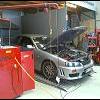Anyone Had Stalling Issues Running A 3" Intake On A 4" Turbo?
Announcements
-
Similar Content
-
Latest Posts
-
By TurboTapin · Posted
Well, my new WMI system took much longer to finalize. I actually missed my dyno appointment last Friday and lost my 150$ deposit. I'll be going back in the next week or two. To sum it up. I only kept the AEM tank from my old setup. I replaced the AEM pump with a higher flow/pressure ProMeth 30GPH pump. I also swapped over to a 6AN low pressure feed line to the pump from the tank. There's also a pressure switch you cannot see on the pump high pressure line. This is feeding 6x 200CC direct port nozzles and 1x 500CC Pre Throttle body nozzle. All fittings are Swagelok, because well why not. I also have a 300PSI pressure sensor up front. I now have my Haltech ECU controlling everything. I start my pump with a basic relay at 5PSI and deadhead it. I then PWM a 3000CC methanol Injector to control flow starting around 10psi. The pressure switch in the trunk, along with my tank level are safeties before I ever get to 10PSI, and then I use my pressure sensor upfront as a secondary safety to cut the WMI and corrections in case the injector blocks or a line ruptures. Wish me luck on the dyno! -
By TurboTapin · Posted
So, I'm back with bad news. There's no jack long enough on this planet that will reach the front subframe. If by some chance there is, it would weigh 200lb's. I purchased a long reach jack... The damn thing weighted 120lb's and was massive. Didn't even come close, was still short at least a foot. It was a pain, but I brought it back. Next I decided HA! No problem, I'll get an Extra long reach jack. Well, I couldn't lift the box... It must have weighed 160LB's and luckily there was an open box in store. I took measurement and was still nowhere close. Sadly I've lost hope and have accepted defeat. -
Thanks for that tip, niZmO_Man. I think the battery is OK. It's quite a new one, but I'll check. Last time I needed a new battery, everything electronic was fine, except that there wasn't enough current to turn over the starter. I decided to order one of the partial AV system translation CDs from Car Audio Workshop in NZ. That might have some effect, or help me diagnose the date problem. 🤞
-
By Dose Pipe Sutututu · Posted
I suppose it was relatively stock too, the JZ motor handle most mods thrown at them without even breaking a sweat -
I saw your intro update, are you sure you've actually had a starter motor failure? You mention it could be the alarm causing it. I'm assuming you've got a no start issue, but what are the exact symptoms, as there could be a few reasons it has stopped wanting to start.
-







Recommended Posts
Create an account or sign in to comment
You need to be a member in order to leave a comment
Create an account
Sign up for a new account in our community. It's easy!
Register a new accountSign in
Already have an account? Sign in here.
Sign In Now